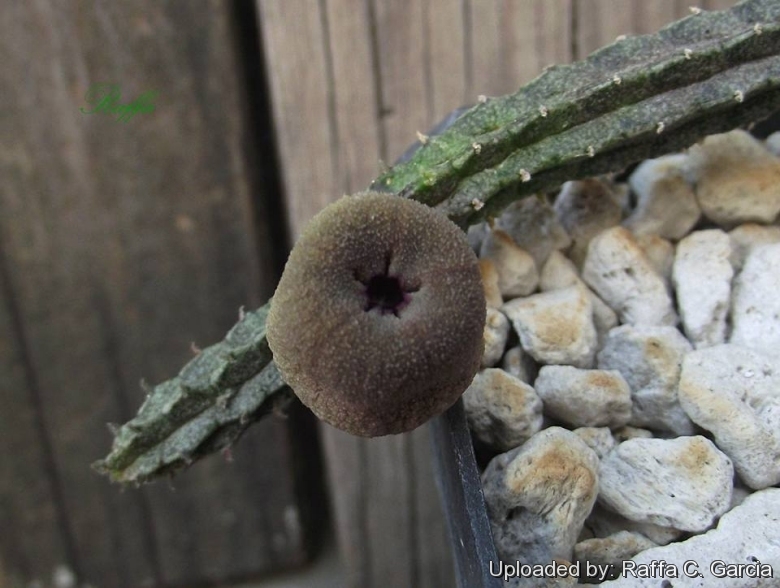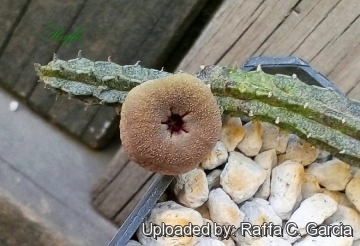Accepted Scientific Name: Echidnopsis malum (Lavranos) Bruyns
Bradleya 6 43 1988.

Pseudopectinaria malum (Echidnopsis malum) Photo by: Raffa C. Garcia
Origin and Habitat: Somalia, Kenya and Ethiopia
Altitude range: from near sea-level to about 1250 metres.
Habitat and ecology: Because of its highly cryptic habit, with the stems largely hidded by leaf detritus or loose stones, Echidnopsis malumSN|33815]]SN|33815]] may well be present in regions where, so far, it has not been observed.
Synonyms:
Description: Echidnopsis malumSN|33815]]SN|33815]] is a small succulent with grey-green or brownish stems, up to 15 cm long or sometimes more, the angles rather indistinctly divided into low rectangular tubercles. The flowers are shaped like an urn, held upright, depressed at the apex and with a pentagonal opening about 4 mm wide. Outside bright green with red streaks, inside dark purple-red and in lower and upper parts with long white hairs, the middle portion somewhat tuberculate. The transverse wrinkling of the corolla-tube is also remarkable, being more pronounced than in any other species. The corolla-lobes are triangular-ovate, about 4 mm long, very fleshy.
Derivation of specific name: The specific name refers to its peculiar flowers resembling tiny apples (Malus is the genus of apples).
Stems. Cylindrical, 5- to 6-ribbed, grey-green, dark grey-green or brownish, trailing along the ground, 3-20 cm long, 8-10 mm thick, the angles laterally compressed and rather indistinctly divided into low rectangular tubercles.
Tubercles. Narrow, elongate.
Leaves: Rudiment broadly triangular to heart-shaped, about 1- .5 mm long, stiff.
Inflorescence: 1-flowered. Pedicel 10-15 mm, and 1.5 mm thick covered with papillae. Sepals lanceolate, 2-3 mm long, papillose.
Flowers: Erect, fleshy. Corolla globose-urceolate, 14-25 long, 18-22 mm in diameter, outer side bright green with red streaks, covered with papillae, inner side dark purple, with many small wrinkles, and white to purple hairs, 1-1.5 mm long. Corolla tube occupying the whole length of the corolla, with a circular opening on the very tip. corolla-lobes triangular, purple, pointing inwards, apically united, 4 x 4 mm. Corona 2-seriate, red, 3.5-5 mm, globose or shaped like an urn, with a circular opening and a recurved toothed margin, inside hairy. Outer corona-lobes shortly deltoid, golden yellow, developed from the base of the urn, lying down on the anther's base. P
Taxonomy: Because of its peculiar stem and flower morphology, some authors prefer a classification of this species in the monotypic genus Pseudopectinaria, However Bruyns (1988) included the genus Pseudopectinaria (P. malum) in Echidnopsis, but the genus was resurrected again by Plowes in 1993. Lavranos (2006) upholds the idea of a genus Pseudopectinaria, emphasizing the amazing ‘‘lobster pot corolla’’and stem characteristics.
Bibliography: Major references and further lectures
1) Focke Albers, Ulrich Meve “Illustrated Handbook of Succulent Plants: Asclepiadaceae: Asclepiadaceae” Volume 4 Springer Science & Business Media, 2002
2) Bruyns “A revision of the genus Echidnopsis Hook. f. (Asclepiadaceae)”. Bradleya: Yearbook of the British Cactus and Succulent Society, 6 43 1988.
3) Cactus and Succulent Journal, Volume 78, 2006
4) M. Gilbert, D. Goyder, J. Lavranos, S. Liede-Schumann, M. Thulin, and J. Venter "Flora Somalia", Vol 3, 2006. [updated by M. Thulin 2008]
5) Pseudopectinaria malum: Lavranos, Cact.Succ. J. (Los Angeles) 43(1): 10 (1971)
6) Plowes D. C. H. “A new account of Echidnopsis Hook.f. (Asclepiadaceae-Stapelieae)”. Haseltonia 1: 65–85.1993
7) M. Thiv and U. Meve “A phylogenetic study of Echidnopsis Hook. f. (Apocynaceae-Asclepiadoideae) - Taxonomic implications and the colonization of the Socotran archipelago” Pl. Syst. Evol. 265: 71–86 (2007)DOI 10.1007/s00606-007-0516-3
 Pseudopectinaria malum (Echidnopsis malum) Photo by: Raffa C. Garcia
Pseudopectinaria malum (Echidnopsis malum) Photo by: Raffa C. GarciaSend a photo of this plant.The gallery now contains thousands of pictures, however it is possible to do even more. We are, of course, seeking photos of species not yet shown in the gallery but not only that, we are also looking for better pictures than those already present.
Read More... Cultivation and Propagation: Echidnopsis malumSN|33815]]SN|33815]] is an easy obliging blooming plant, which is happy in any average succulent house.
Soil: Since roots are quite shallow, use a cactus mix or add extra perlite or pumice to regular soil potting soil. A gritty, very free-draining compost is suitable, and clay pots help the plants to dry out between watering.
Watering: They require moderately watering through the growing season but enjoy plenty of water and some fertiliser in hot weather, this helps them to flower freely. Water more sparingly in winter according to temperatures. But, as with most asclepiads, it is unwise to leave them wet in cold weather.
Hardiness: Winter care presents no problems at 10°C with plenty of light.
Sun Exposure: Partial sun or light shade.
Pest and diseases: They are generally fairly easy to grow, especially if kept pest-free. They are susceptible to stem and root mealy bugs, and damage from these may well initiate fungal attack. If you do have problems with a stem or with basal rotting, you can reliably isolate the healthy parts, dry them off, and re-root them in moist compost.
Cultural Practices: Re-pot every 2 years.
Propagation: Easiest with stem cuttings. Allow cuttings to dry a day before planting. Stems must be laid (Not buried) on gritty compost and will then root from the underside of the stems. It can also be increased from seeds sowing in spring in moist, sandy peat moss. Barely cover seeds.











